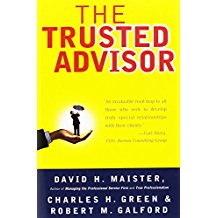Achieve Sales Goals: Turn “Sales Rep’s” Into “Trusted Advisors”
On average 48% of salespeople fail to achieve their sales quotas…why? The number of salespeople not achieving sales plan continues to grow year over year…why? Why do 58% of buyers surveyed share meeting with the sales rep today added no value to the buying process? We have 79% of business buyers share it’s absolutely critical or very important to interact with a salesperson that is a trusted advisor.
It is time we turn “sales rep’s” into “trusted advisors “ and the book: The Trusted Advisor by David Maister gives you a roadmap to accomplish this objective.
The author starts the first chapter with a simple yet critical question I want you to think about.
“What benefits would you realize if your customers trusted you more?”
Maister then goes on to share a list of benefits your company and your sales associate will realize when your buyers trust you more. There is a list of 16 benefits and below are three I have personally experienced.
- They reach out to you for advice
- They bring you in on more advanced strategic issues
- They share more information that helps you help them
This is not the first thought leader to discuss the importance of trust. In Stephen Covey’s book: The Speed of Trust he shares the specific financial impact to your companies’ bottom line when you have high trust.
Where do your salespeople fall on the client advisor relationship spectrum?
First we have salespeople who sell on price. It drives us nuts, we have taught them to sell based on the value our product or solution provided but the reality is they sell on price.
Then we have product experts, subject matter, and process experts. If a client shares a problem with them (big if) then they connect the dots to solve the problem with a product or service.
Next we have the subject matter expert problem solver. This type of salesperson clearly understands their customers, markets and common problems they have. They hunt for customers with those problems and help clients solve them. They are a valuable resource for their customers.
Last and the level very few salespeople achieve is that of the Trusted Advisor. They have product, market, and application knowledge. They also know how to help solve problems. The big difference is they also know the customers business of their business. They have a strong grasp of financial business drivers and business acumen. They ask questions and help customers find better more efficient and effective ways to run their businesses and they have a measurable impact on their customer’s bottom line.
This level of sales professional is seen as a trusted advisor to their customers because they use a value based sales approach.
As you can tell I like to share sales and marketing research findings on why buyers buy and must have in our markets of today to make buying decisions. (Sorry)
To paraphrase the research results from a report by The Rain Group…
“85% of buyers today expect salespeople to present their solution and identify the value it will bring and less than 15% of salespeople today actually meet this key buyer need.”
So how you feeling right now?
Are we hitting a little too close to home?
From my experience with business owners and investors they usually admit this conversation makes them feel a bit uncomfortable.
They know what they want: profitable repeatable growth.
They have invested in a sales team, marketing, operations and often product development to achieve what their shareholders want.
They have invested in sales training but are not seeing sales behaviors change to meet what buyers require today.
Quietly …on their drive home or when they are taking a shower, or if they are like me at 3:00 am a thought interrupts your peace.
“ I don’t think we will hit sales plan and I need to fix this problem”
If you are a salesperson where do you fall in the Client Advisor Sales Spectrum? (be honest its just us)
How much of your day is actually spent helping your customers solving problems? If you are like most salespeople today less than 20% of your time is spent selling.
If you lead a sales organization where do most of your salespeople fall on this spectrum?
From my experience teams typically hover in and out of product experts and problem solvers. Each team has about 10% of salespeople selling based on price and they are significantly underperforming.
If you own a company what impact would it have to have your typically 60% of salespeople on your team who are mid-level sales performers coming in under plan every year produce the results your top 20% of sales performers produce?
When your team is trained to understand market problems and sell with a value based sales model they will become trusted advisors to your customers.
If you want (need) your salespeople to fix their sales problem of not hitting sales goal and profit objectives I highly recommend you buy the book The Trusted Advisor and follow the author’s roadmap to help your team move from “sales rep “ to “trusted advisor”.



